Any well-stocked garage should probably have an air compressor. Surprised? You’ve gotten by for how long without one? You may want to think again because an air compress is a great purchase and an incredibly versatile tool.
An Air Compressor’s Many Uses
An air compress is a tool that creates a high pressure zone for storing compressed air. That air is then released on your command. Why is that useful? It works like a reverse vacuum or perhaps a leaf blower, except with many tool attachments. These tools harness the power of the compressed air and use it to do some very useful things.
Here are some common uses of an air compressor in a garage setting:
- Blowing dirt and leaves out of your garage
- Blowing away wood dust after sanding (and before painting) furniture
- Filling bike, car, and wheel barrow tires or balloons
- Nailing small nails, staples, and brads into place, like when cedar lining a closet
- Sanding or grinding with a pneumatic tool, like with a pneumatic palm sander
- Painting with a spray gun
- Applying grease with a grease gun
- Driving bolts with an impact wrench
The Air Compressor Explained
Here are the parts of typical air compressor…

The main interaction points are the On/Off switch, the output pressure adjustment, and the output port(s). The output port will connect to a hose that then connects to your attachments.
It’s noting at this point that the output pressure adjustment is a regulator between the stored air and the tool at the end of the output hose. Some tools will require more or less air pressure to work well, so you can adjust it with this knob.
Not shown on the image (but it’ll be obvious on most models) is a safety valve that can be pulled to quickly draining air from the tank without using the attached tool. You’ll want to drain the air this each time you are done using the compressor because you never want to store a tank with pressure. Pressurized air can create condensation which, over time, can rust out your compressor tank, hence the drain valve at the bottom. If you want to learn more, read our air compressor drain valve guide.
Air Compressor Tools
An air compressor is useless without tools, often known as attachments. Some popular attachments are:
- Blow gun (how you blow high force air out of the compressor)
- Blow gun with extension
- Dual-head air chuck inflator for Schrader valves (used to fill a bike or car tire)
- Nail Gun
- Angle Grinder
- Paint Sprayer
- Palm Sander
- Impact Wrench
- Grease Gun
- Ratchet
- Air Hammer
- And many more…
The most simple of accessories is a blow gun — which simply releases the compressed air. A blow gun can also have its own attachments, like a rubber tip for getting under surfaces or a valve for filling a basketball. Attachments like this are normally sold in kits, that go for about $25-$50. Such kits are included in some air compressors but won’t be found with base-level models or in professional-grade ones.
Air compressors can drive power tools, like an air hammer, impact driver, brad nailer, or reversible drill. Tools like impact drivers and grinders are typically restricted to larger, more powerful air compressors and you can’t efficiently drive them with a typical 6-gallon home compressor. Look at the SCFM and PSI demands on the tools you want to use and you’ll know what compressor to buy.
SCFM Rating Explained
The easy thing to do when shopping for an air compressor is to look for the capacity (in gallons or liters) and the PSI, and then buy the compressor if those look good. But don’t miss out on checking the Standard CFM (SCFM), which is a measure of airflow from the compressor. After all, high pressure (measured in psi) in the tank is only useful if the air can be put to use. This is exactly what the CFM measures.
Think about it like this: a home compressor like the Porter-Cable below has enough pressure to operation a nailer — because it has a high psi — because moving a nail takes a lot of pressure, not a high volume of air. Operating an air hammer or grinder requires minutes of usage at high pressure, which means high sustained CFM output, not just high psi.
Typically a home air compressor will need 2-5 SCFM, but this can vary greatly depending on the work you plan to do.
At the very bottom of the article you can find some minimum air tool requirements for SCFM and pressure. These will be home garage ratings, not pro-grade ones you’d find in a shop. Keep in mind you’ll need very little SCFM for a brad nailer (around 0.2 SCFM) but a lot for persistent tool, like a die grinder (7 SCFM). In the middle range you’ll have your nibblers, impact drivers, and drill tools.
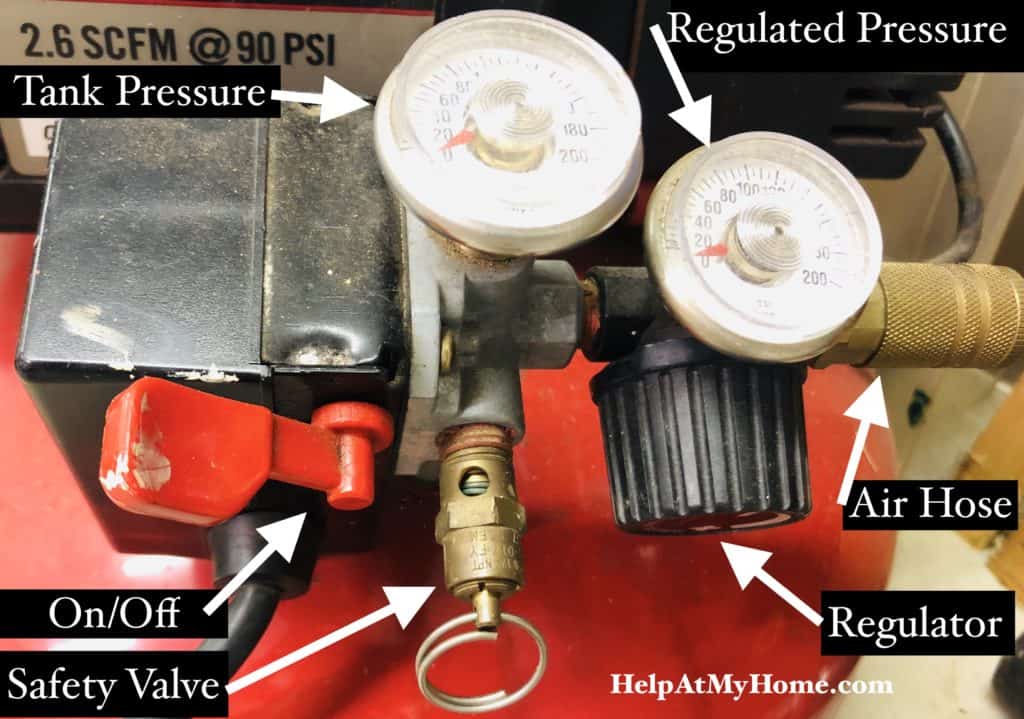
Air Compressor Parts
If you are new to air compressors you might need some explanation on what you are looking at. A typical setup, like on my Porter-Cable in the picture, will have just a few parts you need to know about.
- Tank Pressure Gauge – Indicates the air pressure on the inside of the tank
- Regulated Pressure Gauge – The pressure sent out to the hose. Always less than the air tank pressure
- Regulator – A knob that lowers the pressure from the tank to the outgoing hose
- On/Off Switch – Turns the air compressor on and off
- Safety Valve – This will open if the internal pressure is too high. It can also be pulled so that you can remove the air pressure from your tank. A tank should not be left under pressure when not in use.
- Air Hose Exit – A quick connector where the hose can connected
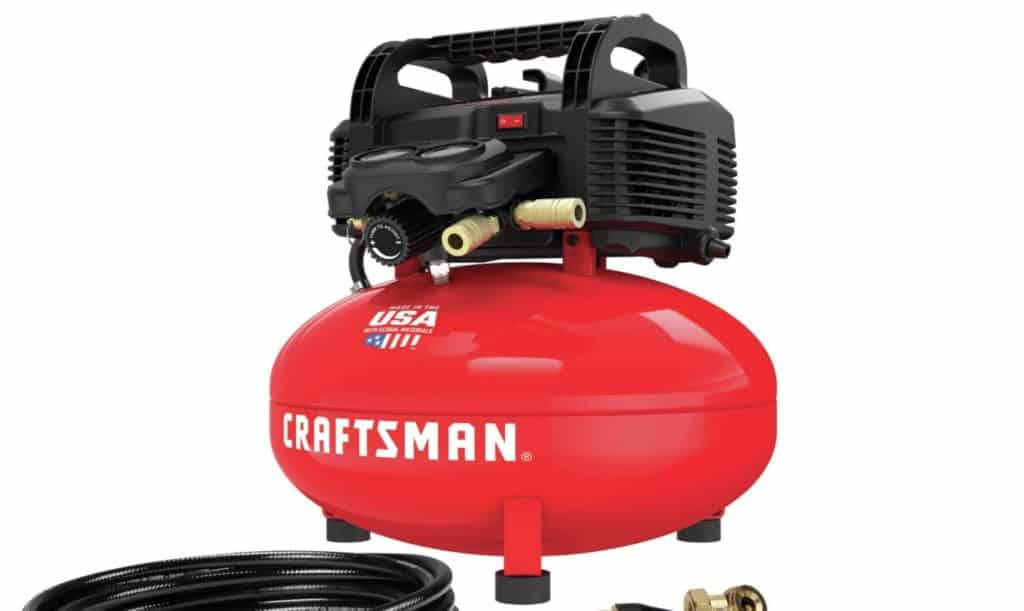
One important item not pictured is the drain valve on the bottom of the air compressor. This is used to drain the bottom of the tank when you are not using it. The tank hold air at high pressure, which causes water to condense on the inside. You don’t want this water sitting at the bottom of your tank, so you need to drain it occasionally.
What To Look For In A Compressor
Home buyers who are new to air compressors usually buy them because they have a specific purpose in mind, like needing a nail gun for an upcoming project or because they want to outfit a garage workshop.
The typical purchase that makes sense will be:
- Pancake-style air compressor
- Oil-free design
- At least 5-gallon capacity
- Over 120 psi maximum air pressure
Secondary considerations should be the SCFM, size, noise level, warranty, accessories, and of course the price. Keep in mind that the price will vary greatly based on the included accessories — a well-kitted compressor might cost twice as much as a barebones one. You might also want to consider the weight and amount of horsepower. More weight and more horsepower aren’t sure-fire signs of quality, but they are indicative of a better compressor.
Many people prefer an oil-free design because it produces cleaner air and less emissions when operating. Oil-free designs are also mandatory for operations in some professional settings, particularly those indoors. Generally speaking, oil-free will be the way to go for the home or light-duty user.
Best Air Compressors For Home
I personally use a Porter-Cable pancake model that is no longer in production (shown above). It’s a 120 psi, 6-gallon unit that has been problem-free for years. I’d recommend it, but it’s no longer for sale. As such, the nearest equivalent is my top pick.
Note: Most base models don’t include a hose or attachments, so they aren’t usable on their own. So watch out for those $99 models, unless you already have accessories.
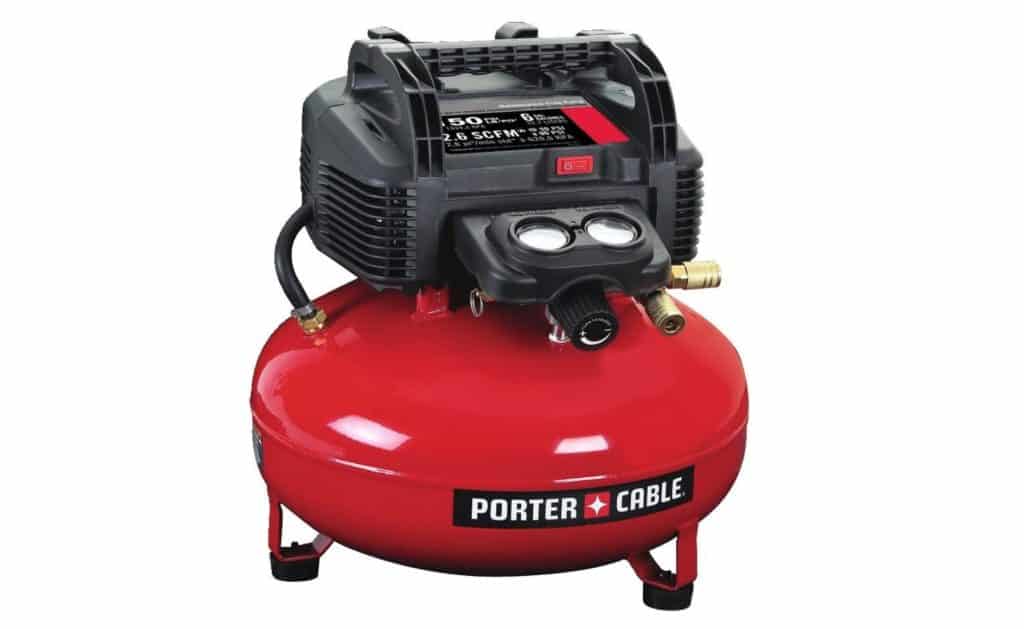
Porter-Cable Model C2002
The Porter-Cable C2002 is a top-selling compressor with great reviews, and it looks great on paper. The top-line specs are…
- 150 psi max pressure
- 6-gallon capacity
- 2.6 SCFM at 90 psi
- Low-volt motor for easy cold weather starts
- Oil-free design
Normally we’d recommend a bigger name, a Dewalt say, but having had my Porter-Cable for so long, the C2002 seems like a downright reasonable choice. It sells for under $100 for just the air compressor or $170 for the all parts you need to get started. Most home buyers will want to go for the full kit, but if you have some parts from an old compressor then you can get away with just the compressor itself.
At 30-pounds this model is easy to move around the garage, a task which is made easier by the handle on top. Combine a fair price, great reviews, useful design, and great reviews and you have a fine purchase.
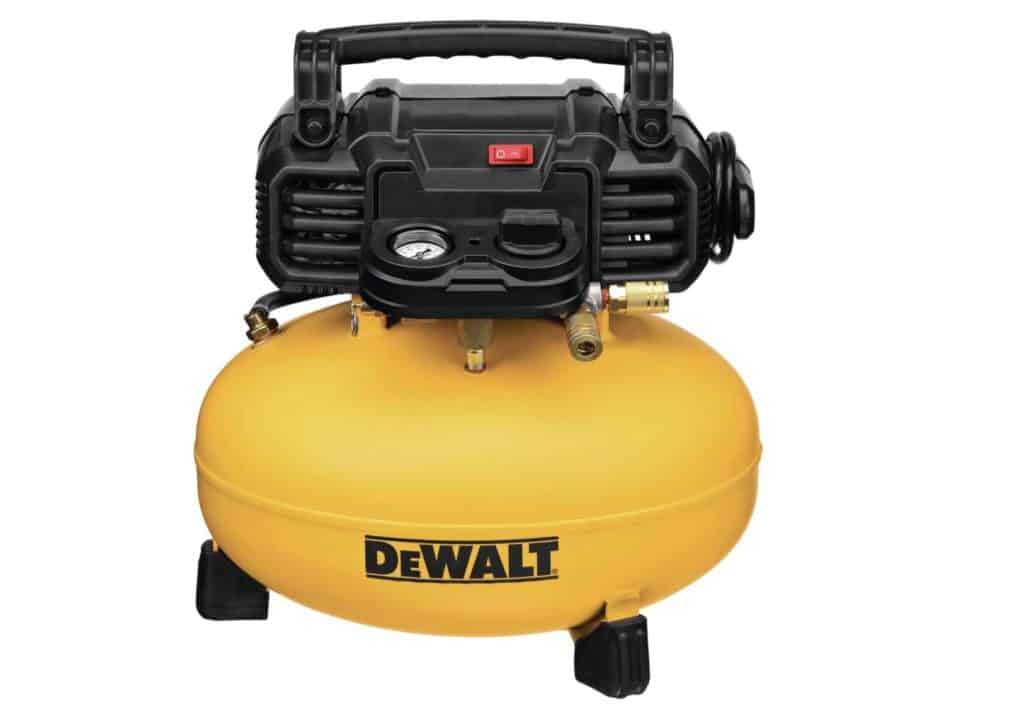
DeWalt Pancake Air Compressor
If you prefer Dewalt tools, there is the DeWalt DWFP55126 air compressor. This model is similar to the Porter but has some slight advantages. This model has the following specs…
- 6-gallon capacity
- 165 maximum psi
- 2.6 SCFM at 90 psi
- 30 pounds
- 0.9 horsepower motor
- 1-year limited warranty
This is a nice air compressor for running a small nail gun, blowing out the shop, and doing other household tasks.
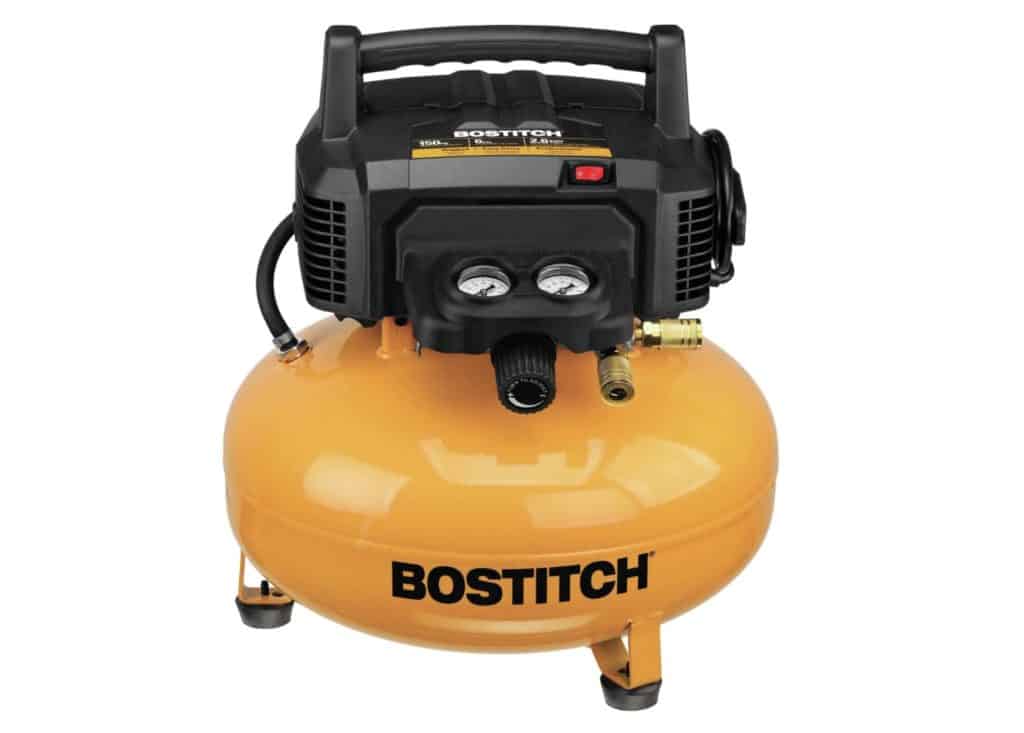
Bostitch Pancake Air Compressor Model BTFP02012
Bostitch’s entry-level BTFP02012 (the yellow model pictured above) is quite similar to the Porter-Cable. It’s a 6-gallon, pancake air compressor with a 150 psi maximum pressure. In fact almost all the specs are the same as found on the C2002.
One difference between this and some other models is the quieter operation, 78.5 dBA in fact. Now that’s not exactly quiet, but it won’t deafen you if the garage doors are shut. At 17 x 17 x 19 inches the size is about average for a pancake compressor.
The Bostitch and Porter-Cable models look to be almost exactly the same, but from our research the Bostitch has a longer hose (about 2 feet longer) and there is a 3-year warranty from Bostitch as opposed to 1-year with Porter-Cable.
One downside is that the motor is just 0.8 horsepower so refill times aren’t as short as they could be.

Makita MAC2400 Air Compressor
Another top pick in the home garage air compressor world is the Makita MAC2400. This compressor has some clear changes from the previous two models. First of all, it’s a dual-tank design (called a “twin stack”), not a pancake, and it’s also oil-lubricated.
This model has more power and higher specs than the other two. What that means on paper is you get 4.2 free air CFM @ 90 psi, up from 2.6. You also get about three times the horsepower of the previous models — 2.5 horsepower vs. 0.8 from the others.
There are some downsides with this model as well though. First of all, it costs a good deal more than the others. It also weighs a hefty 77 pounds, so you aren’t moving this one around too often, even if it is a little bit smaller than the pancake models (18 inches high and 19 inches wide). It’s also a little bit louder than the Bostitch, at 79.0 db.
Long story short: the MAC2400 air compressor can power two nail guns at once and the previous two can’t. There is a good chance that doesn’t matter for you, but it can make a huge difference if you are working with a team.
If this sounds like more than you need, you can look into the Makita MAC100Q or the very popular MAC700. The MAC700 looks smaller, lighter, and easier to move around, but it’s still 60 pounds, so don’t be deceived into thinking it’s light duty. It’s best to see one in the store before ordering online if at all possible.

Craftsman 6-Gallon Compressor
If you want an alternative to the Porter-Cable or the Bostitch then you can opt for the Craftsman 6-gallon pancake compressor. These are all essentially the same unit, with some slight changes to the accessories included, which means you can safely shop around when making your purchase and find the best deal. Like the Porter, this model has an oil-free design, 150 psi maximum, and 2.6 SCFM at 90 psi, but this has a handsome accessory kit to get you started.
FAQs
What is an oil-free air compressor?
Some air compressors are oil-lubricated while other are oil-free. Oil-free air compressors do not use oil to lubricated movings parts, but rather have replaceable parts and special low-friction surfaces them. Oil-lubricated air compressors used to be quieter and longer-lasting than oil-free models, but that’s no longer the case as oil-free designs have improved greatly over the years.
What is a pancake air compressor?
A pancake air compressor is a model with a single tank that is a flat, elliptical (or saucer) shape. Pancake compressors are typically used for home usage with tanks that are under 7 gallons in volume. The design is lightweight but awkward to carry because the width of the tank.
What is a hot dog air compressor?
A hot dog air compressor is a model with a single tank that is long and shaped like a pill or like a short hot dog. The shape is typically easier to carry than a pancake compressor, but is heavier for a given air volume. A typical hot dog compressor for home use is the Makita MAC700.
What size air compressor is best for a home garage?
Most popular home air compressors range from 5 to 10 gallons in size. Size isn’t an ideal measurement on its own size CFM (air flow) is very important for choosing an air compressor and this will determine what tools the compressor can use. But if you have practical size and weight restrictions in your home or shop then you’ll be best served with something over 2 gallons and under 10, with most people buying a 6-gallon pancake-style compressor.
What is a good air compressor for my car?
Typically when buying an air compressor for your car you’ll want something that is 12V, which means it can be powered by the cigarette lighter adapter in your car. The air compressors in this article draw power from a 120V wall outlet so aren’t good for auto use. They can, of course, fill car tires or help wash a car that’s in your garage or driveway, but they won’t help fix a flat tire when away from home.
Air Tool PSI and SCFM Requirements
| Tool | Pressure Needed (psi) | SCFM Needed (@90 psi) |
| Stapler | 70 | 0.3 |
| Brad Nailer (18 gauge) | 70 | 1.2 |
| Tire Inflation | 80 | 2 |
| Framing Nailer | 100 | 2.2 |
| Drill | 80 | 3 |
| Impact Wrench (1/2″) | 90 | 4 |
| Impact Driver (1/2″) | 90 | 4 |
| Spraygun (Paint) | 90 | 4 |
| Grease Gun | 90 | 4 |
| Angle Grinder | 80 | 5 |
| Orbital Sander | 80 | 6 |
| Die Grinder | 70 | 7 |
| Dual Sander | 90 | 7 |

